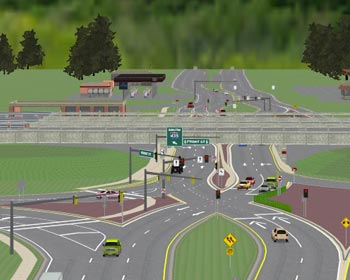New Methods Developed for Assessing Innovative Intersection and Interchange Designs
Posted: Sep 2, 2019
 MPC researchers have developed new testing modules to more rapidly assess the safety and operational performance of continuous flow intersections and diverging diamond interchanges. The modules will cut planning time and costs for implementing the intersection designs. It is estimated that the use of the modules would take about 5% of the time needed to develop microsimulation models for each individual site. Microsimulation models are the primary method currently used for assessing performance of these intersection designs.
MPC researchers have developed new testing modules to more rapidly assess the safety and operational performance of continuous flow intersections and diverging diamond interchanges. The modules will cut planning time and costs for implementing the intersection designs. It is estimated that the use of the modules would take about 5% of the time needed to develop microsimulation models for each individual site. Microsimulation models are the primary method currently used for assessing performance of these intersection designs.
These intersection designs have been widely adopted and seem to offer improved traffic performance and safety due to their innovative designs. The designs also have a broad impact on operations, safety, access, transit, land use, economic development, and pedestrian and non-motorized traffic. However, to date there have been few defined guidelines or methods for evaluating these innovative intersection and interchange designs.
Using the modules on test sites in Utah, MPC researchers found that a diverging diamond interchange can reduce vehicle delays by more than 60% and total crashes by 25%. A continuous flow intersection can reduce vehicular delays by close to 40% and total crashes by 12%. A diverging diamond interchange can also benefit transit and non-motorized transportation due to the smaller footprint than a regular diamond interchange.
Milan Zlatkovic, Ph.D.
University of Wyoming
Development of Performance Matrices for Evaluating Innovative Intersections and Interchanges
MPC-19-391